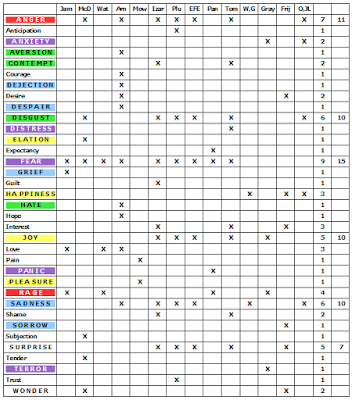In about two months, Disney•Pixar's newest feature film, Inside Out, will be released in theaters. Always a sucker for Disney•Pixar and the old-school animated Disney films, I'm excited to see their new movie. Excited AND interested!
Inside Out, cleverly advertised as an “emotion picture,” is about the interplay of emotions inside the movie's main (human) characters and how this interplay manifests itself in their behavior. Each main (human) character houses a set of five personified emotions: Anger, Disgust, Fear, Joy, and Sadness.
Curious as to why Inside Out depicts those particular emotions, I did some web-surfing to see what great minds have postulated as humankind's basic emotions. I quickly found that there is very little consensus on an exact set of basic emotions. I based most of my more thorough web-researching on the information presented by changingminds.org located on this web page: http://www.changingminds.org/explanations//emotions/basic%20emotions.htm. Below is a thumbnail of a table containing content I reorganized based on said webpage. It shows 14 different conceptions of basic human emotions. (Click the thumbnail to see an enlarged and much more readable image. See footnotes to the table at the bottom of this post.)

The table shows that the emotions most agreed upon are anger, disgust, fear, joy, and sadness … AND surprise! (See second to last column for exact totals.) However, if you combine synonymous terms (hence the color coding) and total the numbers, surprise falls off a bit. (See the last column.) Maybe that's how Disney•Pixar chose their five emotions for Inside Out. Or maybe they went with Oatley and Johnson-Laird's set because it's the most recent of the 14 theories given on changingminds.org and various other sources. Oatley and Johnson-Laird's list contains the emotions personified in Inside Out but with somewhat different labels: anger, disgust, anxiety (fear?), happiness (joy?), and sadness.
As someone who continues to struggle with my own emotions, I fully understand how researchers over the past hundred years have varied so much in their conclusions. It may seem strange to some, but just a year or so ago I was virtually unable to answer my therapist's question, “How did that make you feel?” I think my emotional vocabulary has expanded, but I still sometimes struggle to label how I feel.
Emotions are important. I hope Inside Out helps adults and children alike recognize their importance and how they influence our interactions with and behavior towards one another. Check out the official trailer from Disney•Pixar's youtube channel below.
NOTE: For full citations, please visit changingminds.org: http://www.changingminds.org/explanations//emotions/basic%20emotions.htm.
Footnotes to the table above:
Jam = William James (1890)? changingminds.org states that James's list of basic emotions comes from his 1884 work, “What Is an Emotion?” I could not verify this. The same list does appear in his 1890 work, The Principles of Psychology, in which he characterizes them as “coarser emotions.”
McD = William McDougall (1926).
Wat = John B. Watson (1930).
Arn = Magda B. Arnold (1960)? I was unable to locate a corresponding source for Arnold's theory of basic emotions.
Mow = Orval Hobart Mowrer (1960).
Izar = Carroll Izard (1977)? changingminds.org states that Izard's list of basic emotions includes distress. Other sources I saw were consistent in his inclusion of sadness rather than distress. Not having read Izard's work directly, I went with the majority in the image above.
Plu = Robert Plutchik (1980).
EFE = Paul Ekman, Wallace V. Friesen, and Phoebe Ellsworth (1982).
Pank = Jaak Panksepp (1982). Panksepp has since expanded his list of basic emotional systems. In the image above I only included the four he gave in his 1982 work.
Tom = Silvan Tomkins (1984).
W,G = Bernard Weiner and Sandra Graham (1984)? I was unable to locate a corresponding source for Weiner and Graham's theory of basic emotions.
Gray = Jeffrey Gray (1985)? I was unable to locate a corresponding source for Gray's theory of basic emotions.
Frij = Nico Frijda (1986).
O,JL = Keith Oatley and Phil Johnson-Laird (1987).
Note: Comments are open to all—anyone can comment and anyone can read comments. If you'd rather send me a private message, fill out the Contact Form (located just below the Subscribe and Follow by Email sections). The Contact Form works beautifully. I tried it out myself.
Thanks for reading! It's great to hear from you. -J
Hi J! Interesting posts on the movie and I did watch the trailer. It looks good! and it is certainly an important subject! and it is good to be sensitive to the emotions of others. For instance, I think it is wonderful that you share your therapy experiences and interpretations of what you have learned through your experiences because that shows genuine concern for helping others.
ReplyDeleteTake care, my sister